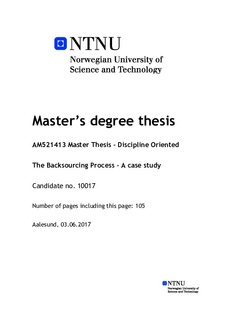| dc.description.abstract | This study examines the backsourcing process in detail. Previous research regarding
backsourcing has mainly focused on the process before the decision to backsource has been
made. Research regarding what happens after the decision has been made and the contract
with the external supplier has been terminated, is rather limited. This is the starting point for
this study. The research question is thus to examine how companies conduct the backsourcing
process and identify different internal challenges that may occur during this process.
A qualitative case study was used to describe the backsourcing process. The study involved
one unique case of a supplier of maritime equipment in Møre & Romsdal. The case study
included in-depth interviews with a selected number of employees and stakeholders. The
interviews revealed important drivers, activities and challenges related to the backsourcing
process. In addition, the interviews with the stakeholders revealed how the decision to
backsource affected the case company’s competitive advantages from an external perspective.
Based on the interviews, a framework as for how companies can conduct the backsourcing
process was identified, consisting of four phases comprised with different objectives and
activities. Moreover, three main challenges related to the backsourcing process was identified,
namely limitations in capacity, re-building knowledge, and adapting the backsourced product
to the production site. The findings indicate that all three challenges occurred during the third
phase of the backsourcing process, which implies that phase three is a critical phase in the
backsourcing process and imply that managers should pay particular attention to this phase.
The main contribution of this research is the development of a stepwise model as for how
companies can backsource. In addition to filling a gap in the existing literature, the framework
can also be used as an analytic tool that might help managers in dealing with the backsourcing
process, and the decisions and challenges related to this process. | nb_NO |

